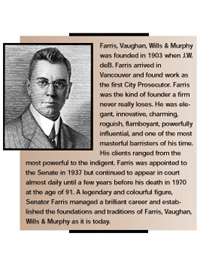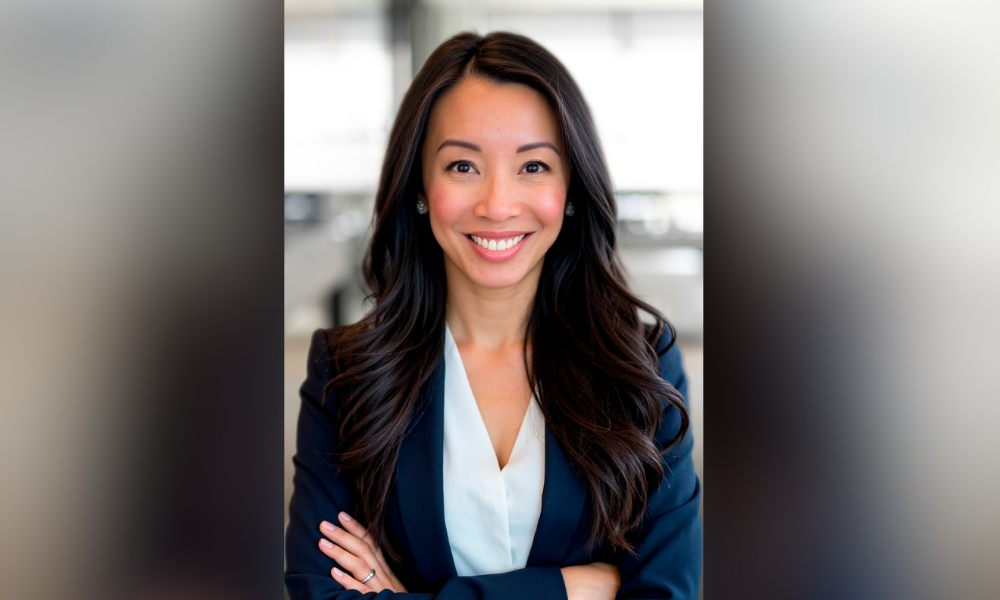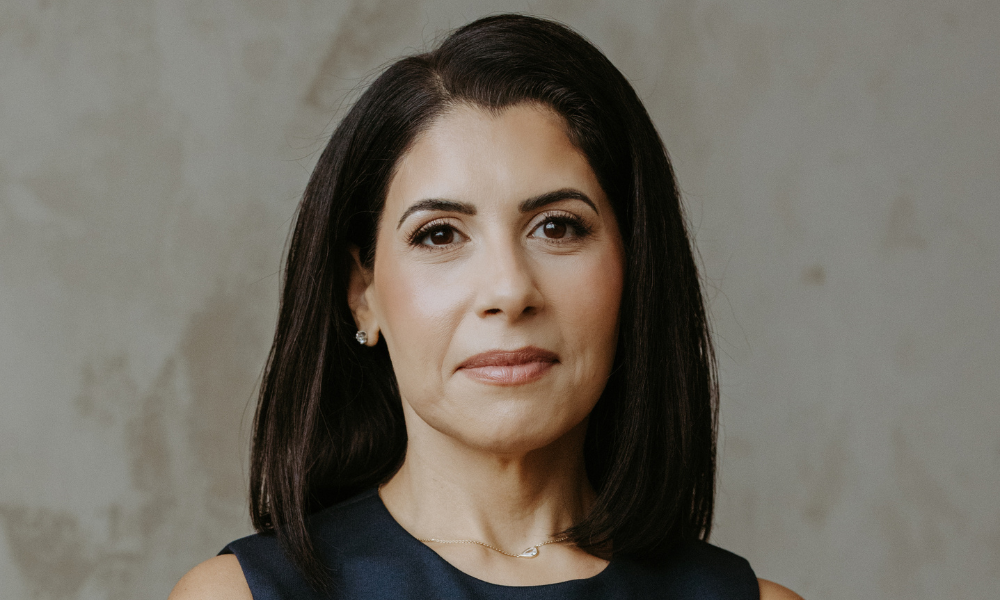\"Farris Who?” asked the Bay Street lawyer. Reputed to be one of the most profitable law firms in Vancouver, 70-lawyer Farris, Vaughan, Wills & Murphy is one of British Columbia’s best kept secrets. In B.C. business and government circles, however, the enduring success of Farris Vaughan is anything but secret. For high-end, B.C.-based corporate work, Farris is rivalled only by Ladner Downs and Lawson Lundell Lawson & McIntosh. In litigation, Farris has set the benchmark, jockeying for top spot with Russell & DuMoulin. Last year, almost half the firm’s thirty partners were recognized by Lexpert as leading practitioners in their respective practice areas.
“I would describe them as a high performance law firm,” says David Unruh, Senior Vice President, Law and Corporate Secretary of Westcoast Energy Inc., the largest corporation in B.C. and a longstanding client of Farris. The firm’s clients range from blue chip institutions to emerging technology companies. BC TEL, another longstanding client, relied on a team of Farris lawyers in its $9.9 billion merger earlier this year with Alberta-based TELUS Corporation. Other clients include BC Gas Inc., the City of Vancouver, B.C.’s largest credit union, well-known satellite technology company MacDonald Dettwiler, and biotechnology company QLT PhotoTherapeutics. Farris also has been representing the B.C. lumber industry in the ongoing softwood lumber dispute with the United States. Farris lawyers do act regularly for clients based outside the province as well, including the federal government, the TD Bank and Hollinger Inc.
In addition to client envy, Farris often generates culture envy - or, at least, culture curiosity - in the legal community. No committee meetings. No billable hour budgets. No firm retreats. No written partnership agreement. Few partners’ meetings. “We avoid committees like the plague,” explains senior corporate partner Elizabeth (Betty) Harrison, Q.C. . When leading corporate lawyer Mitch Gropper, Q.C., joined Farris in 1998 after 28 years at McCarthy Tétrault (and its predecessor firm Shrum, Liddle & Hebenton), he found the absence of management-by-committee palpable and refreshing. “People just know what to do,” he says.
It is tempting to attribute the strong Farris culture to its relatively small size. Partners in large Bay Street firms are fond of reminiscing about the good old days in the early 1980’s when firms were small and management was easy. “We’ve always been about half the size as the largest firm in the city,” confirms managing partner Keith Mitchell, Q.C., in a manner that suggests that smaller size does,indeed, matter. However, interviews with members of the firm and clients suggest that there is something more sophisticated at work.
The secret of Farris Vaughan’s success is straightforward according to Mitchell, only the fifth managing partner in the firm’s 96-year history. “Good clients provide good work. Good work attracts good lawyers. Good lawyers attract and keep good clients.” So how does a firm hop on this self-perpetuating merry-go-round of success? The right lawyers provide a leg up and Mitchell has another straightforward explanation. “We hire the best, pay the best and expect the best.” One of Farris Vaughan’s top litigators, George Macintosh, takes a stab at explaining the firm’s values and sounds a lot like Mitchell. “The expectation is that you’re there to try as hard as you can for the client. It sounds simple, but it isn’t. It is a deeper ethic.” Certainly, one element of working “as hard as you can for the client” is working long hours. Westcoast’s Unruh observes, “They are extremely hard-working. Service is provided on demand in a prompt, efficient manner.” Corporate partner and rising star Cam Belsher joined Farris three years ago. Belsher was no stranger to hard work at his former firm, Ladner Downs. However, Belsher discovered that everyone at Farris works hard, “significantly” harder, on average, than at other firms in Vancouver. “There are no floaters.” Long hours would explain the firm’s financial success. In the economics of professional service firms, hours at the margin all fall to the bottom line. And, it is easier to log long hours when one is unencumbered by administrative and politburo duties.
David Unruh explains that he means something more than “hard-working” when he describes Farris as a “high performance” law firm. “Each of the senior lawyers (at Farris),” says Unruh, “is multidisciplinary in themselves. Each has the ability to step out of their speciality areas and offer broad, practical advice. This is one of the firm’s inherent strengths. Keith (Mitchell), for example, has good relationships with senior officers (at Westcoast). He is able to blend legal knowledge with community knowledge and political acumen to give very practical advice.” Other clients strike up similar refrains.
“I think Al Hamilton walks on water,” says Shelley Lanza, Senior Vice President and General Counsel of Starbucks Coffee Company in Seattle. Starbucks retained Hamilton and his employment and labour colleagues at Farris when Starbucks poured over the U.S. border into B.C. several years ago. Starbucks discovered a labour environment and regulatory regime that they had not encountered elsewhere. B.C. remains the only jurisdiction in the world in which Starbucks’ employees are unionized. “He (Hamilton) did a beautiful job of counselling us through a new situation. He spent a lot of time to understand what a union meant to us,” recounts Lanza. “They (Farris) are not afraid to help make business decisions, which is a rarity in law firms... We have issues all over the States and we choose the best counsel around. He (Hamilton) is one of the top counsel that I have worked with. He is one of the few who has the confidence to get involved in business decisions and not just give legal advice.”
The Farris culture breeds generalists at the senior level. A significant role model for the generalist approach was Frank Murphy, the firm’s managing partner through the 1970’s and 1980’s. Murphy is described in reverent tones as a “lawyers’ lawyer” by most of the partners interviewed. Betty Harrison explains that Murphy believed that “one should be capable of picking up and dealing with anything. The (firm’s) intellectual property practice was built on that basis.”
How does Farris find good clients to build its intellectual property practice? The old fashioned way: by doing good work. Biotechnology company QLT “discovered” Farris when the firm was acting for the underwriter in QLT’s 1989 initial public offering. Ever since then, Farris has acted for QLT as it has grown from a local company with a market capitalization of $25 million to an international company with a market capitalization of over $3 billion. Farris, led by corporate partner Hector MacKay-Dunn, not only looks after QLT’s financings (six equity deals so far), they also protect QLT’s intellectual property and negotiate their strategic alliances around the world. “If we go to Switzerland or Japan, we take a Farris lawyer with us. It is unusual to find a local firm that can act globally,” explains QLT’s CFO Kenneth Galbraith. The commonly accepted wisdom at many firms these days is that clients are demanding more specialists. Maybe so - at certain levels. The Farris track record suggests, however, that if you want to follow your clients around the world - or at least down to New York to raise money - it is important to be able to offer generalist advice at the most senior levels.
The generalist approach permeates the litigation group as well. George Macintosh, for example, currently is busy with commercial litigation (representing the Griffiths family of Vancouver in “round two” of the shareholders’ dispute over control of WIC Communications) at the same time as he is representing 39 of 41 RCMP officers being investigated in connection with the APEC meetings in Vancouver. Macintosh explains that, as a litigator, he “always fears the generalists the most (as opposing counsel). I’d rather deal with the specialists on the other side anytime.” Who else but a generalist would have himself pepper-sprayed - as Macintosh did - in order to level the playing field with potential witnesses at the APEC inquiry?
Good clients. Good work. Good lawyers. “Our goal has always been to be the pre-eminent law firm in B.C.,” says Mitchell. Farris has spun an enduring reputation for expertise and connections in the province. This reputation is not lost on outsiders who find themselves in need of advice in B.C. “It was obvious that (Farris) is highly regarded by government officials,” says Lanza of Starbucks. “On regulatory issues we were able to cut through issues quickly. We enjoy the benefits of that (reputation).”
The Farris focus on B.C.-based law and clients has meant that it has resisted waves of local and national mergers and alliances in the past 15 years. “The firm is still the same firm I knew when I started,” says Betty Harrison. “Working as hard as you can for the client” and producing generalists at the senior level are threads woven throughout the firm’s history. These values do not mean that the firm doesn’t change. The lateral recruitment of Gropper and Belsher at the partner level was a departure for the firm. Farris also has implemented a new partner admission policy. While most firms are simply extending the partnership window or introducing two-tier structures to respond to economic pressures in the new marketplace, Farris has taken a different approach. Associates at Farris now are responsible for initiating the approach when they believe they are ready to be considered for partnership. Unique, bold and, at many other firms, such a policy would be fraught with difficulty. But then, Farris Vaughan is not like most other firms. And further, it’s no longer a secret.
Timothy G. Leishman is a principal of Fraser Leishman, a Toronto-based consultancy with expertise in strategies for recruiting, retaining and accelerating the professional development of top talent in law firms.
“I would describe them as a high performance law firm,” says David Unruh, Senior Vice President, Law and Corporate Secretary of Westcoast Energy Inc., the largest corporation in B.C. and a longstanding client of Farris. The firm’s clients range from blue chip institutions to emerging technology companies. BC TEL, another longstanding client, relied on a team of Farris lawyers in its $9.9 billion merger earlier this year with Alberta-based TELUS Corporation. Other clients include BC Gas Inc., the City of Vancouver, B.C.’s largest credit union, well-known satellite technology company MacDonald Dettwiler, and biotechnology company QLT PhotoTherapeutics. Farris also has been representing the B.C. lumber industry in the ongoing softwood lumber dispute with the United States. Farris lawyers do act regularly for clients based outside the province as well, including the federal government, the TD Bank and Hollinger Inc.
In addition to client envy, Farris often generates culture envy - or, at least, culture curiosity - in the legal community. No committee meetings. No billable hour budgets. No firm retreats. No written partnership agreement. Few partners’ meetings. “We avoid committees like the plague,” explains senior corporate partner Elizabeth (Betty) Harrison, Q.C. . When leading corporate lawyer Mitch Gropper, Q.C., joined Farris in 1998 after 28 years at McCarthy Tétrault (and its predecessor firm Shrum, Liddle & Hebenton), he found the absence of management-by-committee palpable and refreshing. “People just know what to do,” he says.
It is tempting to attribute the strong Farris culture to its relatively small size. Partners in large Bay Street firms are fond of reminiscing about the good old days in the early 1980’s when firms were small and management was easy. “We’ve always been about half the size as the largest firm in the city,” confirms managing partner Keith Mitchell, Q.C., in a manner that suggests that smaller size does,indeed, matter. However, interviews with members of the firm and clients suggest that there is something more sophisticated at work.
The secret of Farris Vaughan’s success is straightforward according to Mitchell, only the fifth managing partner in the firm’s 96-year history. “Good clients provide good work. Good work attracts good lawyers. Good lawyers attract and keep good clients.” So how does a firm hop on this self-perpetuating merry-go-round of success? The right lawyers provide a leg up and Mitchell has another straightforward explanation. “We hire the best, pay the best and expect the best.” One of Farris Vaughan’s top litigators, George Macintosh, takes a stab at explaining the firm’s values and sounds a lot like Mitchell. “The expectation is that you’re there to try as hard as you can for the client. It sounds simple, but it isn’t. It is a deeper ethic.” Certainly, one element of working “as hard as you can for the client” is working long hours. Westcoast’s Unruh observes, “They are extremely hard-working. Service is provided on demand in a prompt, efficient manner.” Corporate partner and rising star Cam Belsher joined Farris three years ago. Belsher was no stranger to hard work at his former firm, Ladner Downs. However, Belsher discovered that everyone at Farris works hard, “significantly” harder, on average, than at other firms in Vancouver. “There are no floaters.” Long hours would explain the firm’s financial success. In the economics of professional service firms, hours at the margin all fall to the bottom line. And, it is easier to log long hours when one is unencumbered by administrative and politburo duties.
David Unruh explains that he means something more than “hard-working” when he describes Farris as a “high performance” law firm. “Each of the senior lawyers (at Farris),” says Unruh, “is multidisciplinary in themselves. Each has the ability to step out of their speciality areas and offer broad, practical advice. This is one of the firm’s inherent strengths. Keith (Mitchell), for example, has good relationships with senior officers (at Westcoast). He is able to blend legal knowledge with community knowledge and political acumen to give very practical advice.” Other clients strike up similar refrains.
“I think Al Hamilton walks on water,” says Shelley Lanza, Senior Vice President and General Counsel of Starbucks Coffee Company in Seattle. Starbucks retained Hamilton and his employment and labour colleagues at Farris when Starbucks poured over the U.S. border into B.C. several years ago. Starbucks discovered a labour environment and regulatory regime that they had not encountered elsewhere. B.C. remains the only jurisdiction in the world in which Starbucks’ employees are unionized. “He (Hamilton) did a beautiful job of counselling us through a new situation. He spent a lot of time to understand what a union meant to us,” recounts Lanza. “They (Farris) are not afraid to help make business decisions, which is a rarity in law firms... We have issues all over the States and we choose the best counsel around. He (Hamilton) is one of the top counsel that I have worked with. He is one of the few who has the confidence to get involved in business decisions and not just give legal advice.”
The Farris culture breeds generalists at the senior level. A significant role model for the generalist approach was Frank Murphy, the firm’s managing partner through the 1970’s and 1980’s. Murphy is described in reverent tones as a “lawyers’ lawyer” by most of the partners interviewed. Betty Harrison explains that Murphy believed that “one should be capable of picking up and dealing with anything. The (firm’s) intellectual property practice was built on that basis.”
How does Farris find good clients to build its intellectual property practice? The old fashioned way: by doing good work. Biotechnology company QLT “discovered” Farris when the firm was acting for the underwriter in QLT’s 1989 initial public offering. Ever since then, Farris has acted for QLT as it has grown from a local company with a market capitalization of $25 million to an international company with a market capitalization of over $3 billion. Farris, led by corporate partner Hector MacKay-Dunn, not only looks after QLT’s financings (six equity deals so far), they also protect QLT’s intellectual property and negotiate their strategic alliances around the world. “If we go to Switzerland or Japan, we take a Farris lawyer with us. It is unusual to find a local firm that can act globally,” explains QLT’s CFO Kenneth Galbraith. The commonly accepted wisdom at many firms these days is that clients are demanding more specialists. Maybe so - at certain levels. The Farris track record suggests, however, that if you want to follow your clients around the world - or at least down to New York to raise money - it is important to be able to offer generalist advice at the most senior levels.
The generalist approach permeates the litigation group as well. George Macintosh, for example, currently is busy with commercial litigation (representing the Griffiths family of Vancouver in “round two” of the shareholders’ dispute over control of WIC Communications) at the same time as he is representing 39 of 41 RCMP officers being investigated in connection with the APEC meetings in Vancouver. Macintosh explains that, as a litigator, he “always fears the generalists the most (as opposing counsel). I’d rather deal with the specialists on the other side anytime.” Who else but a generalist would have himself pepper-sprayed - as Macintosh did - in order to level the playing field with potential witnesses at the APEC inquiry?
Good clients. Good work. Good lawyers. “Our goal has always been to be the pre-eminent law firm in B.C.,” says Mitchell. Farris has spun an enduring reputation for expertise and connections in the province. This reputation is not lost on outsiders who find themselves in need of advice in B.C. “It was obvious that (Farris) is highly regarded by government officials,” says Lanza of Starbucks. “On regulatory issues we were able to cut through issues quickly. We enjoy the benefits of that (reputation).”
The Farris focus on B.C.-based law and clients has meant that it has resisted waves of local and national mergers and alliances in the past 15 years. “The firm is still the same firm I knew when I started,” says Betty Harrison. “Working as hard as you can for the client” and producing generalists at the senior level are threads woven throughout the firm’s history. These values do not mean that the firm doesn’t change. The lateral recruitment of Gropper and Belsher at the partner level was a departure for the firm. Farris also has implemented a new partner admission policy. While most firms are simply extending the partnership window or introducing two-tier structures to respond to economic pressures in the new marketplace, Farris has taken a different approach. Associates at Farris now are responsible for initiating the approach when they believe they are ready to be considered for partnership. Unique, bold and, at many other firms, such a policy would be fraught with difficulty. But then, Farris Vaughan is not like most other firms. And further, it’s no longer a secret.
Timothy G. Leishman is a principal of Fraser Leishman, a Toronto-based consultancy with expertise in strategies for recruiting, retaining and accelerating the professional development of top talent in law firms.
Lawyer(s)
David G. Unruh
Mitchell H. Gropper
A. Keith Mitchell
George K. Macintosh
Cameron Belsher
Shelley Lanza
R. Hector MacKay-Dunn
Firm(s)
FARRIS
Lawson Lundell LLP
Westcoast Energy Inc. - Pipeline & Field Servs. Div.
TELUS
FortisBC Holdings Inc.
TD Bank (The)
Hollinger Inc.
McCarthy Tétrault LLP
Starbucks Coffee Company





